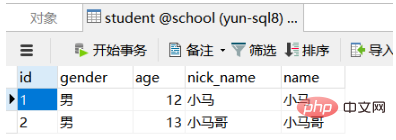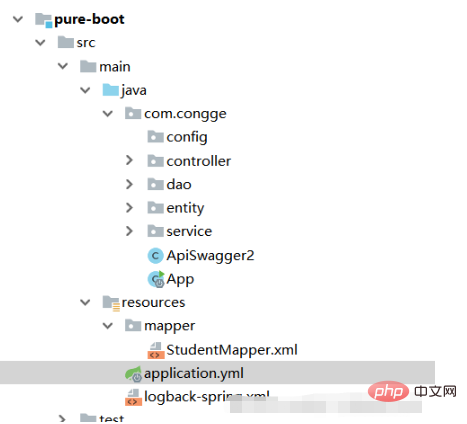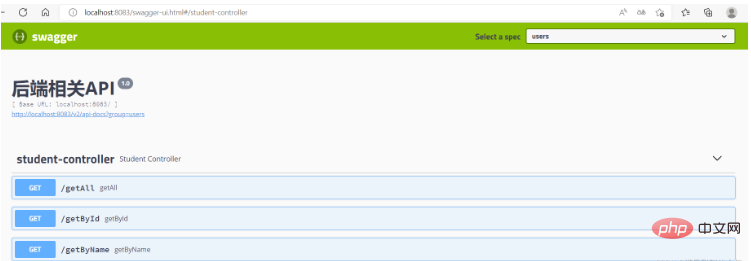How SpringBoot integrates mybatis+mybatis-plus
Preparation work
1. Prepare the following data table
CREATE TABLE `student` ( `id` varchar(32) NOT NULL, `gender` varchar(32) DEFAULT NULL, `age` int(12) DEFAULT NULL, `nick_name` varchar(32) DEFAULT NULL, `name` varchar(32) DEFAULT NULL, PRIMARY KEY (`id`) ) ENGINE=InnoDB DEFAULT CHARSET=utf8;
2. Insert several pieces of test data

Integration steps
The complete package structure of the project is shown in the figure

1. Import maven dependencies
<parent>
<groupId>org.springframework.boot</groupId>
<artifactId>spring-boot-starter-parent</artifactId>
<version>2.1.1.RELEASE</version>
<relativePath/> <!-- lookup parent from repository -->
</parent>
<properties>
<project.build.sourceEncoding>UTF-8</project.build.sourceEncoding>
<project.reporting.outputEncoding>UTF-8</project.reporting.outputEncoding>
<java.version>1.8</java.version>
<mysql-connector-java.version>8.0.11</mysql-connector-java.version>
<commons-lang3.version>3.7</commons-lang3.version>
<fastjson.version>1.2.47</fastjson.version>
<mybatis-plus-boot-starter.version>3.3.0</mybatis-plus-boot-starter.version>
<mybatis-plus-generator.version>3.3.0</mybatis-plus-generator.version>
<druid.version>1.1.14</druid.version>
<lombok.version>1.18.0</lombok.version>
<dubbo-spring-boot-starter.version>2.0.0</dubbo-spring-boot-starter.version>
<swagger.version>2.9.2</swagger.version>
<swagger-bootstrap-ui.version>1.9.6</swagger-bootstrap-ui.version>
</properties>
<dependencies>
<dependency>
<groupId>org.apache.commons</groupId>
<artifactId>commons-lang3</artifactId>
<version>3.4</version>
</dependency>
<dependency>
<groupId>org.springframework.boot</groupId>
<artifactId>spring-boot-starter-web</artifactId>
</dependency>
<!--mysql依赖-->
<dependency>
<groupId>mysql</groupId>
<artifactId>mysql-connector-java</artifactId>
<version>${mysql-connector-java.version}</version>
</dependency>
<!--阿里巴巴fastjosn依赖-->
<dependency>
<groupId>com.alibaba</groupId>
<artifactId>fastjson</artifactId>
<version>${fastjson.version}</version>
</dependency>
<!--阿里巴巴数据库连接池依赖-->
<!-- Druid -->
<dependency>
<groupId>com.alibaba</groupId>
<artifactId>druid-spring-boot-starter</artifactId>
<version>${druid.version}</version>
</dependency>
<dependency>
<groupId>org.mybatis.spring.boot</groupId>
<artifactId>mybatis-spring-boot-starter</artifactId>
<version>2.1.1</version>
</dependency>
<!-- MyBatis增强工具-->
<dependency>
<groupId>com.baomidou</groupId>
<artifactId>mybatis-plus-boot-starter</artifactId>
<version>${mybatis-plus-boot-starter.version}</version>
</dependency>
<dependency>
<groupId>com.baomidou</groupId>
<artifactId>mybatis-plus-generator</artifactId>
<version>${mybatis-plus-generator.version}</version>
</dependency>
<!-- lombok -->
<dependency>
<groupId>org.projectlombok</groupId>
<artifactId>lombok</artifactId>
<version>${lombok.version}</version>
</dependency>
<!--swagger-ui-->
<dependency>
<groupId>io.springfox</groupId>
<artifactId>springfox-swagger2</artifactId>
<version>${swagger.version}</version>
</dependency>
<dependency>
<groupId>io.springfox</groupId>
<artifactId>springfox-swagger-ui</artifactId>
<version>${swagger.version}</version>
</dependency>
<dependency>
<groupId>com.github.xiaoymin</groupId>
<artifactId>swagger-bootstrap-ui</artifactId>
<version>${swagger-bootstrap-ui.version}</version>
</dependency>
</dependencies>2. Configuration file application.yml
server:
port: 8083
logging:
config: classpath:logback-spring.xml #日志
spring:
datasource:
driver-class-name: com.mysql.cj.jdbc.Driver
url: jdbc:mysql://IP:3306/school?autoReconnect=true&useUnicode=true&characterEncoding=utf8&serverTimezone=GMT%2B8&useSSL=false
username: root
password: root
druid:
max-active: 100
initial-size: 10
max-wait: 60000
min-idle: 5
#设置单个文件最大上传大小
servlet:
multipart:
max-file-size: 20MB
mybatis-plus:
mapper-locations: classpath*:mapper/*.xml
global-config:
db-column-underline: true #开启驼峰转换
db-config:
id-type: uuid
field-strategy: not_null
refresh: true
configuration:
map-underscore-to-camel-case: true
#log-impl: org.apache.ibatis.logging.stdout.StdOutImpl #打印sql语句便于调试3. In order to facilitate the debugging interface later, add a swagger configuration
import org.springframework.context.annotation.Bean;
import org.springframework.context.annotation.Configuration;
import springfox.documentation.builders.ApiInfoBuilder;
import springfox.documentation.builders.PathSelectors;
import springfox.documentation.builders.RequestHandlerSelectors;
import springfox.documentation.service.ApiInfo;
import springfox.documentation.spi.DocumentationType;
import springfox.documentation.spring.web.plugins.Docket;
import springfox.documentation.swagger2.annotations.EnableSwagger2;
/**
* swagger文档,项目启动后,浏览器访问:http://localhost:8083/swagger-ui.html
*/
@Configuration
@EnableSwagger2
public class ApiSwagger2 {
@Bean
public Docket createRestBmbsApi() {
return new Docket(DocumentationType.SWAGGER_2)
.groupName("users")
.apiInfo(apiInfo())
.select()
.apis(RequestHandlerSelectors.basePackage("com.congge.controller"))
.paths(PathSelectors.any())
.build();
}
private ApiInfo apiInfo() {
return new ApiInfoBuilder()
.title("后端相关API")
.version("1.0")
.build();
}
}4. Entity class
import com.baomidou.mybatisplus.annotation.TableField;
import lombok.Data;
@Data
public class Student {
@TableField("id")
private String id;
@TableField("name")
private String name;
@TableField("gender")
private String gender;
@TableField("age")
private int age;
@TableField("nick_name")
private String nickName;
}5. Dao interface, add a method to query all data
import com.baomidou.mybatisplus.core.mapper.BaseMapper;
import com.congge.entity.Student;
import org.apache.ibatis.annotations.Mapper;
import java.util.List;
@Mapper
public interface StudentMapper extends BaseMapper<Student> {
List<Student> queryAll();
}6. Mybatis layer, write sql files
<?xml version="1.0" encoding="UTF-8"?>
<!DOCTYPE mapper PUBLIC "-//mybatis.org//DTD Mapper 3.0//EN" "http://mybatis.org/dtd/mybatis-3-mapper.dtd">
<mapper namespace="com.congge.dao.StudentMapper">
<select id="queryAll" resultType="com.congge.entity.Student">
select * from student
</select>
</mapper>7. Business implementation class
In this business implementation, you can use the mybatis method and mybatis- Plus method, choose based on your own needs when using it specifically;
import com.baomidou.mybatisplus.core.conditions.query.QueryWrapper;
import com.congge.dao.StudentMapper;
import com.congge.entity.Student;
import com.congge.service.StudentService;
import org.springframework.stereotype.Service;
import javax.annotation.Resource;
import java.util.List;
@Service
public class StudentServiceImpl implements StudentService {
@Resource
private StudentMapper studentMapper;
@Override
public List<Student> queryAllStudent() {
QueryWrapper<Student> queryWrapper = new QueryWrapper();
List<Student> students = studentMapper.selectList(queryWrapper);
return students;
//return studentMapper.queryAll();
}
@Override
public List<Student> getByName(String name) {
QueryWrapper<Student> queryWrapper = new QueryWrapper();
queryWrapper.like("name",name);
return studentMapper.selectList(queryWrapper);
}
public Student getById(String id) {
QueryWrapper<Student> queryWrapper = new QueryWrapper();
queryWrapper.like("id",id);
return studentMapper.selectOne(queryWrapper);
}
}8. Add a test interface
@RestController
public class StudentController {
@Autowired
private StudentService studentService;
@GetMapping("/getAll")
public List<Student> getAll(){
return studentService.queryAllStudent();
}
@GetMapping("/getByName")
public List<Student> getByName(@RequestParam String name){
return studentService.getByName(name);
}
@GetMapping("/getById")
public Student getById(@RequestParam String id){
return studentService.getById(id);
}
}9. Start the class
import org.springframework.boot.SpringApplication;
import org.springframework.boot.autoconfigure.SpringBootApplication;
@SpringBootApplication
public class App {
public static void main(String[] args) {
SpringApplication.run(App.class,args);
}
}Next, Run the project and test it
10. After starting, open the swagger interface


You might as well test two randomly Let’s use an interface and test it to get the data interface of all students

The above is the detailed content of How SpringBoot integrates mybatis+mybatis-plus. For more information, please follow other related articles on the PHP Chinese website!

Hot AI Tools

Undresser.AI Undress
AI-powered app for creating realistic nude photos

AI Clothes Remover
Online AI tool for removing clothes from photos.

Undress AI Tool
Undress images for free

Clothoff.io
AI clothes remover

Video Face Swap
Swap faces in any video effortlessly with our completely free AI face swap tool!

Hot Article

Hot Tools

Notepad++7.3.1
Easy-to-use and free code editor

SublimeText3 Chinese version
Chinese version, very easy to use

Zend Studio 13.0.1
Powerful PHP integrated development environment

Dreamweaver CS6
Visual web development tools

SublimeText3 Mac version
God-level code editing software (SublimeText3)

Hot Topics
 1662
1662
 14
14
 1419
1419
 52
52
 1313
1313
 25
25
 1262
1262
 29
29
 1235
1235
 24
24
 iBatis vs. MyBatis: Which one is better for you?
Feb 19, 2024 pm 04:38 PM
iBatis vs. MyBatis: Which one is better for you?
Feb 19, 2024 pm 04:38 PM
iBatis vs. MyBatis: Which should you choose? Introduction: With the rapid development of the Java language, many persistence frameworks have emerged. iBatis and MyBatis are two popular persistence frameworks, both of which provide a simple and efficient data access solution. This article will introduce the features and advantages of iBatis and MyBatis, and give some specific code examples to help you choose the appropriate framework. Introduction to iBatis: iBatis is an open source persistence framework
 Comparative analysis of the functions and performance of JPA and MyBatis
Feb 19, 2024 pm 05:43 PM
Comparative analysis of the functions and performance of JPA and MyBatis
Feb 19, 2024 pm 05:43 PM
JPA and MyBatis: Function and Performance Comparative Analysis Introduction: In Java development, the persistence framework plays a very important role. Common persistence frameworks include JPA (JavaPersistenceAPI) and MyBatis. This article will conduct a comparative analysis of the functions and performance of the two frameworks and provide specific code examples. 1. Function comparison: JPA: JPA is part of JavaEE and provides an object-oriented data persistence solution. It is passed annotation or X
 Detailed explanation of the Set tag function in MyBatis dynamic SQL tags
Feb 26, 2024 pm 07:48 PM
Detailed explanation of the Set tag function in MyBatis dynamic SQL tags
Feb 26, 2024 pm 07:48 PM
Interpretation of MyBatis dynamic SQL tags: Detailed explanation of Set tag usage MyBatis is an excellent persistence layer framework. It provides a wealth of dynamic SQL tags and can flexibly construct database operation statements. Among them, the Set tag is used to generate the SET clause in the UPDATE statement, which is very commonly used in update operations. This article will explain in detail the usage of the Set tag in MyBatis and demonstrate its functionality through specific code examples. What is Set tag Set tag is used in MyBati
 Various ways to implement batch deletion operations in MyBatis
Feb 19, 2024 pm 07:31 PM
Various ways to implement batch deletion operations in MyBatis
Feb 19, 2024 pm 07:31 PM
Several ways to implement batch deletion statements in MyBatis require specific code examples. In recent years, due to the increasing amount of data, batch operations have become an important part of database operations. In actual development, we often need to delete records in the database in batches. This article will focus on several ways to implement batch delete statements in MyBatis and provide corresponding code examples. Use the foreach tag to implement batch deletion. MyBatis provides the foreach tag, which can easily traverse a set.
 Detailed explanation of how to use MyBatis batch delete statements
Feb 20, 2024 am 08:31 AM
Detailed explanation of how to use MyBatis batch delete statements
Feb 20, 2024 am 08:31 AM
Detailed explanation of how to use MyBatis batch delete statements requires specific code examples. Introduction: MyBatis is an excellent persistence layer framework that provides rich SQL operation functions. In actual project development, we often encounter situations where data needs to be deleted in batches. This article will introduce in detail how to use MyBatis batch delete statements, and attach specific code examples. Usage scenario: When deleting a large amount of data in the database, it is inefficient to execute the delete statements one by one. At this point, you can use the batch deletion function of MyBatis
 Detailed explanation of MyBatis cache mechanism: understand the cache storage principle in one article
Feb 23, 2024 pm 04:09 PM
Detailed explanation of MyBatis cache mechanism: understand the cache storage principle in one article
Feb 23, 2024 pm 04:09 PM
Detailed explanation of MyBatis caching mechanism: One article to understand the principle of cache storage Introduction When using MyBatis for database access, caching is a very important mechanism, which can effectively reduce access to the database and improve system performance. This article will introduce the caching mechanism of MyBatis in detail, including cache classification, storage principles and specific code examples. 1. Cache classification MyBatis cache is mainly divided into two types: first-level cache and second-level cache. The first-level cache is a SqlSession-level cache. When
 Detailed explanation of MyBatis first-level cache: How to improve data access efficiency?
Feb 23, 2024 pm 08:13 PM
Detailed explanation of MyBatis first-level cache: How to improve data access efficiency?
Feb 23, 2024 pm 08:13 PM
Detailed explanation of MyBatis first-level cache: How to improve data access efficiency? During the development process, efficient data access has always been one of the focuses of programmers. For persistence layer frameworks like MyBatis, caching is one of the key methods to improve data access efficiency. MyBatis provides two caching mechanisms: first-level cache and second-level cache. The first-level cache is enabled by default. This article will introduce the mechanism of MyBatis first-level cache in detail and provide specific code examples to help readers better understand
 In-depth understanding of the batch Insert implementation principle in MyBatis
Feb 21, 2024 pm 04:42 PM
In-depth understanding of the batch Insert implementation principle in MyBatis
Feb 21, 2024 pm 04:42 PM
MyBatis is a popular Java persistence layer framework that is widely used in various Java projects. Among them, batch insertion is a common operation that can effectively improve the performance of database operations. This article will deeply explore the implementation principle of batch Insert in MyBatis, and analyze it in detail with specific code examples. Batch Insert in MyBatis In MyBatis, batch Insert operations are usually implemented using dynamic SQL. By constructing a line S containing multiple inserted values




